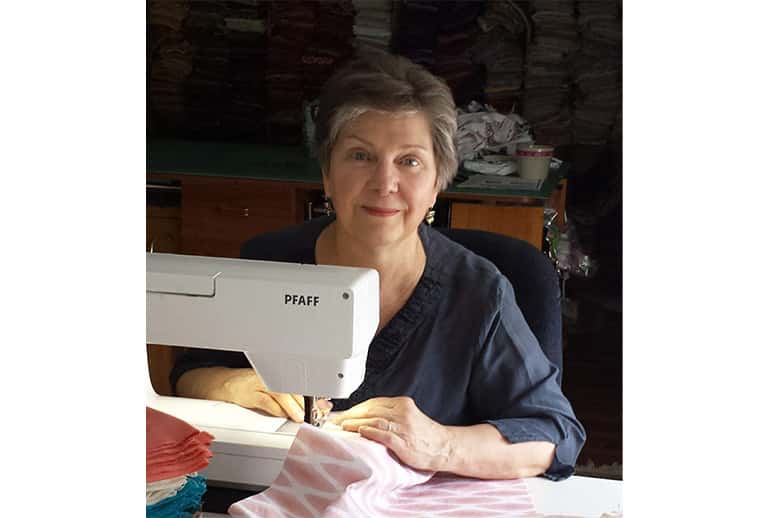
Maker Mondays: Catherine Gentile on Quilting and Community
- Linda Cabot

Catherine Gentile has always been an artmaker. An immaculate quilter and knitter, she has spent her life sharing her knowledge and passion for textiles with generations of women across Massachusetts, from her time spent running the quilting department at Boston’s legendary Windsor Button Shop, to teaching her own courses as the owner of the Button Box Quilt Shop for 21 years. Now she’s a founding member of Sew-N-Sew, a Natick-based nonprofit that gathers people together around a common love of the Fiber Arts.
As one of our local artisans, there’s a good chance that she has stitched the piece that you now have in your home. Catherine has handmade many of our face masks, Tencel scarves, table runners and napkins, and of course, our quilts and coverlets. We’re so proud to have her in the Linda Cabot Design family, and are so excited to share her story with you as the first entry of our Maker Monday series – highlighting the artists and makers behind the work that we love. Read on for Catherine’s reflections on her lifetime of artmaking, shared below in her own words.

What was your earliest exposure to creating art?
I was lucky enough to be born into an artistic family. My great uncle was an architect who painted fine watercolors. My mother painted oil portraits. She was the kind of Girl Scout leader who drove us all to the clay cliffs by the seashore in Glen Cove, NY, to collect different colors of clay. We dried the clay and made paints like the Native Americans for our art badge.
My grandmother taught me hand embroidery and hand sewing starting at aged six. My Little Women doll ended up with an amazing wardrobe. All kinds of art and music were encouraged. We didn’t watch much television as kids, just an hour a day. Instead, we copied the paintings of the great masters with a vast collection of crayons. I still have some of those drawings somewhere.
What is your favorite medium to create with?
I love fabric: [the] feel, color, type and history of the patterns. … When my husband was transferred to Germany, I studied more oil painting and then tapestry weaving at the industrial school in Sindelfingen. I also started my first quilt, poring over what pattern books I could find. A limited but good quality collection of cottons had been stocked by the local military PX and I started teaching myself hand quilting. I loved it right away. I had been designing and making my own clothes for many years and now had a whole new field of play.

If you have a company, when did you start it and what led you to enter into business?
My husband traveled a lot for business and as an Air Force Reserve officer. I was home with baby twins. Sewing kept me sane. … It was work I could do at home. The basement playroom was divided into two sections – the twins played in one half and mommy had the other half. We could watch each other and chat so I got a lot of sewing done.
Eventually, I had enough small quilts to enter a curated craft show in Westport, CT. I was a success and I expanded to another [show in] Wilton, taking commissions at both.
I [also] started teaching quilting locally. I was hired by Boston’s legendary Windsor Button Shop to run a quilting department in their newest store. In 1995, I opened my own shop, Button Box Quilt Shop in Needham, MA. We moved twice as we expanded, ending in Wellesley. I retired after twenty-one years.
What do you see as your mission as a creative and as a business owner?
As a business owner and working mother, my artistic outlet was limited to my shop displays and classes. Quilting was fast becoming a popular outlet with a boom in new tools to modernize the craft. Grandma’s hand sewing methods were not suited to a busy mother and working woman’s hobby.
I taught my customers and employees to use the new tools to economize time spent on the busy work of cutting the pieces and to use the new sewing machine accessories to sew quickly but precisely. This left time to play with color and embellish the projects with hand quilting, embroidery or machine stitching. … We always assisted with color and value choices in making fabric selections. This allowed our cautious new quilters “permission” to make a quilt that doesn’t look just like the pattern cover, instead reflecting their own favorites.

How do you incorporate sustainability into your creative process?
Quilts are made from cotton scraps. The leftovers are put into other projects. When only shreds remain, they are collected for a group that makes dog and cat beds for animal shelters. Nothing goes to waste.
Who or what are your biggest creative influences? What most inspires you?
Women of my generation and before were not taught to go out on their own. They were trained for marriage and children and told they could not handle business, math or science. So many of my customers were so afraid they might make a “mistake” that they never progressed beyond repeating simple beginner projects over and over. My goal was to liberate the older group. In a few short years the world changed for women and doors slowly started opening. Many of the younger ladies were working in higher-end business, science and medicine – they wanted a mental challenge that was relaxing but taught to them quickly and efficiently. Yipes, what a challenge: to bring along both groups, one slowly the other quickly, to reach a point where skills and creativity were equalized and they could work together.
My own level of quilting expertise and design was far above my average customers. I had to analyze how I chose color and fabric prints for projects and how to teach that knowledge to my two groups. I started short monthly club meetings to teach different skills including color for quilters. Each month we would explore one type of color, analogous, complementary colors for instance. We would have a month to make several six-inch quilt blocks for homework. At the end of our course, we had one hundred quilt blocks for a king-sized quilt. We also had student quilt shows. I insisted on hanging work from the ladies who had little self-confidence. The public praise created smiles all around and suddenly, my two groups started sewing together.
When you hit a creative block, what are some techniques you use to push past that block?
Just making fabric combinations is inspirational. My fabrics are sorted by type: American vintage Civil War replications, 1930’s, Australian aboriginals, African animals, Japanese prints, etc. I have several project boxes or works in progress. If I get bored or stuck with one, I can switch gears and move on to another.
I [also] look at books of paintings [or] pictures of the flowers in my garden and think about how I would create a quilt from that picture: a fabric landscape, a quilt block from a flower shape, etc.
What are some ways in which you support other makers? What does creative community mean to you?
At the Button Box, we had over twenty “groups” that met monthly. These were ladies who met to sew on a particular day of the month all year long. When our building was sold and we had to close, there was panic among the groups. The groups consisted of women from all backgrounds who may never have met socially. A love of sewing was their common ground. They were friends and wanted to continue spending time together.
A group of customers and I got together and opened a non-profit sewing space in Natick, MA. We pay for it with annual memberships to the same groups. We work on our own projects together, teach classes and sew for different charity groups: quilts for Project Linus, masks and pillowcases for homeless shelters, children in crisis, quilts for veterans and elder homes. We have created four scholarships for local girls entering nursing programs.
How has the pandemic affected your work if at all? How have you adapted?
What would we do without Zoom? Our groups were completely virtual for several months. Now, some of the ladies feel safe meeting in our sewing space that has been set up according to CDC guidelines. The rest of us are still virtual for a few more months. I have been more productive than ever… For every quilt of my own that I finish, I make four quilts for Project Linus [or] for the elder home.
Personally, COVID has been difficult. I lost my funny, healthy, young brother to COVID back when it was new and was being treated erratically. I worry about my two sons who are out working in the world. My breast cancer has reared its ugly head again after fifteen years requiring three months of treatment. Sewing and my Zoom groups have kept me sane.

What is bringing you joy right now?
I have a lot of fun finding ways to create new quilts using just what is in my stash. Even the large pieces for the back are pieced. I try to get some “sewing therapy” every day. It is so relaxing.
I enjoy the quiet of not having to leave the house. I still see my friends and family more than I ever did before thanks to Zoom. I have not seen my little grandson since he was nine months old. Now, at two, he Zooms with me every week.
_______________________________________________________________________________________
Catherine’s non-profit, Sew-N-Sew, is always happy to welcome new members. If you’d like to reach her, you can send her an email through the Sew-N-Sew Contact Us page, Attn: Catherine.
Get Updates
Enter your email address to follow this blog and receive notifications of new posts by email.
Error: No feed found.
Please go to the Instagram Feed settings page to create a feed.
